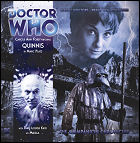 Still moving from place to place after leaving their home planet, the Doctor and Susan arrive on the planet Quinnis, a world in the fourth universe. The TARDIS has landed in a market square, and the haggard-looking people of Quinnis seem ready to sell the time travelers anything in exchange for curiosities from their travels – but especially water, as rain has become a rarity. The Doctor quickly grows impatient with the primitive state of scientific knowledge, but is amazed by the local architecture: the town is a vertical maze of unfinished bridges, and the dwellings along its streets are boats, permanently moored to the bridges. Since he’s already performed one miracle – the TARDIS appearing out of thin air – the Doctor is mistaken for a rainmaker, and his protests to the contrary are ignored. The locals want him to make it rain – or else – to trigger their planet’s brief harvest. But even the bountiful vegetation on the ground level could prove to be deadly, especially when the ensuing monsoon washes the TARDIS away.
Still moving from place to place after leaving their home planet, the Doctor and Susan arrive on the planet Quinnis, a world in the fourth universe. The TARDIS has landed in a market square, and the haggard-looking people of Quinnis seem ready to sell the time travelers anything in exchange for curiosities from their travels – but especially water, as rain has become a rarity. The Doctor quickly grows impatient with the primitive state of scientific knowledge, but is amazed by the local architecture: the town is a vertical maze of unfinished bridges, and the dwellings along its streets are boats, permanently moored to the bridges. Since he’s already performed one miracle – the TARDIS appearing out of thin air – the Doctor is mistaken for a rainmaker, and his protests to the contrary are ignored. The locals want him to make it rain – or else – to trigger their planet’s brief harvest. But even the bountiful vegetation on the ground level could prove to be deadly, especially when the ensuing monsoon washes the TARDIS away.
written by Marc Platt
directed by Lisa Bowerman
music by Nigel FairsCast: Carole Ann Ford (Susan Foreman), Tara-Louise Kaye (Meedla)
Notes: The fish that Susan acquires on Quinnis is seen again when Susan returns to the TARDIS in the eighth Doctor audio story Relative Dimensions (2010). The ending of this story hints strongly that the TARDIS travelers’ next stop is London in the summer of 1963 (a few months prior to the events of the first-ever Doctor Who television story, An Unearthly Child), although this creates a dating problem with the Telos novella “Time And Relative”, which implies that the Doctor and Susan have been in London since 1962. In keeping with the mythology of the series during the Hartnell era, neither the Time Lords nor Gallifrey are ever mentioned.
Timeline: before An Unearthly Child (main story flashback); between An Earthly Child and Relative Dimensions (“present” story)
LogBook entry and TheatEar review by Earl Green
Review: It’s a risky thing, setting a Doctor Who story before An Unearthly Child – in the history of officially-licensed Doctor Who media, there have been only two other attempts (the Telos novellas “Time And Relative” and “Frayed”). Quinnis is Big Finish’s first attempt to roll the clock back before the beginning of the TV series, and it paints an interesting picture of wanderings in a universe dangerous enough to make a junkyard in London, 1963, look safe by comparison.
 Carole Ann Ford and Tara-Louise Kaye provide a surprising variety of character voices between them; as Susan is recounting the story in the “present day” (decades after being left on Earth in The Dalek Invasion Of Earth), the difference between her narration and the voice of the younger Susan is a matter of pitch (actually rather astonishingly effective). Her impersonation of the late William Hartnell is equally impressive, recreating his occasionally sputtering, bordering-on-ad-lib delivery remarkably well.
Carole Ann Ford and Tara-Louise Kaye provide a surprising variety of character voices between them; as Susan is recounting the story in the “present day” (decades after being left on Earth in The Dalek Invasion Of Earth), the difference between her narration and the voice of the younger Susan is a matter of pitch (actually rather astonishingly effective). Her impersonation of the late William Hartnell is equally impressive, recreating his occasionally sputtering, bordering-on-ad-lib delivery remarkably well.
Marc Platt has written tales of the first Doctor and Susan before – albeit in an alternate timeline, in the Doctor Who Unbound audio stories Auld Mortality and A Storm Of Angels – and demonstrates a good working knowledge of the cadence of their conversations and relationships, which is all the more impressive since we barely got to see the Doctor and Susan interacting without Ian or Barbara. Quinnis also nicely sets up precisely why the Doctor is infuriated when the two teachers board his TARDIS in An Unearthly Child.
Platt also convincingly creates a truly alien environment, one that even the current series, awash in CGI, might have trouble depicting. In one sense, this flies in the face of the budget-addled early days of Doctor Who, but it’s no more and no less fantastic than, say, Vortis (a.k.a. The Web Planet). It’s a fascinating, vividly-described setting for a story that seems populated by very few legitimate “good guys.”
